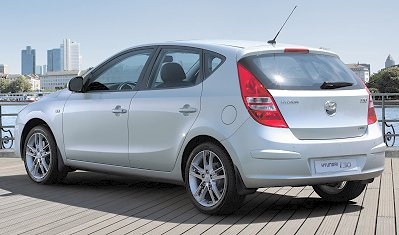
An observation that the car at first glance resembles a styling pastiche derived from Honda, Fiat, BMW and a few other manufacturers, can easily be forgiven. Once inside the car and with express orders to drive it, the styling puzzle tends to become a lot less significant. And the adage about imitation being the most sincere form of flattery springs to mind.
New name
Hyundai's i30 is the first in the manufacturer's new crop of models to adopt an alpha-numeric naming structure. With the "I" symbolising "inspiration", the number will be used to refer to the segment. New Atos and Getz models, for example, will be renamed i10 and i20.
But back to the i30. Essentially a hatchback version of the Elantra, this all-new model has been identified as a brand ambassador for its very ambitious parent company.
Competing in the super-competitive C-segment, Hyundai makes no bones about the fact that an aggressive attack on this segment, in which the VW Golf is currently the car to beat, is underway.
And how does it intend on doing this? Well, the car has a decidedly European "look and feel" to it, which several factions of the local motoring public should appreciate. Not unattractive, it does however look a lot like a confused world traveler from the outside.
But slip into the comfortable driver's seat, close the door with a reassuring "thunk", take in the quality finishes and away you go. This car is further confirmation that the Korean manufacturer is no longer content with being an "also ran" and the overall driving experience and quality levels are comparable with that found in the class leaders.
Top quality
Inside the cabin, the quality of finishes is good. I especially liked the soft touch materials on the door armrest. The arrangement of the hangdown section is neat and logical, too.
Comfort features are of a high standard and almost everything electric has a place in the cabin. In Europe, even entry-level models have the integrated audio system, height adjustment for the driver's seat and power front seats.
With the integrated audio system, allowance is made for a variety of entertainment options with the provision of a plug-in adaptor for iPods, USB and other auxiliary audio equipment in the centre storage bin.
Space within the cabin is ample for the small family, with rear legroom enough to ensure even longer-limbed family members remain comfortable on longer trips. And the luggage space is large enough to swallow even the bulkiest tog bag. A 60/40 folding split rear bench allows for added space.
Even on the choppiest roads, the i30 remains composed, thanks to its proven independent McPherson strut and multi-link rear suspension arrangement.
On the road
The ride is also fairly firm, and with a body that is wider than it is high (a track of just over 1.5 m versus a 1.4 m height), the i30 is rather agile on a set of bends, too. Of course, adjusting to driving on the "wrong" side of the road always presents problems of its own...
Power is provided by a range of petrol and turbodiesel engines. Local variants will likely be propelled by 1.6- and 2.0-litre petrol powerplants, with the inclusion of a 1.6 turbodiesel also under consideration for this market.
The petrol 1.6 produces 90 kW at 6 200 r/min from its 1 591cm3, with peak torque of 154 Nm at 4 200 r/min. On the road, the 1.6 provides sufficient power to the hatchback and while the figures indicate power in the higher rev ranges, it's very usable at pedestrian speeds too.
The 1.6-litre turbodiesel produces 85 kW and 255 Nm at 4 000 and 2 000 r/min respectively through a 16-valve DOHC unit using common rail direct injection technology. This diesel unit is more than happy to amble along at pedestrian speeds, although it also loves a rev or two, as demonstrated along a stretch of quiet back roads.
But on the whole, the turbodiesel is quietly content, displaying very little lag and practically zero engine clatter, even while idling.
The 2.0-litre unit is good for 105 kW at 6 000 r/min and develops 186 Nm of torque at 4 500 r/min.
All engines drive through a five-speed manual gearbox with shifts that are smooth and positive. Fuel consumption on the combined cycle for the models driven is quoted at 6.2- and 4.7 l/100 km.
More models to follow
The i30 is largely based on the handsome Arnejs concept car shown at last year's Paris Motor Show, and a Crosswagon version will be unveiled at the Frankfurt Motor Show in September. Whether the wagon will be launched in South Africa remains to be seen.
According the Hyundai, a third model is being considered for introduction too, though this is likely to take the form of a sporty three-door hatchback or a convertible.
i30 becomes available in South Africa from March or April 2008, with pricing said to aimed directly at the Golf/Focus/Astra/Auris segment.




 Publications
Publications
 Partners
Partners











